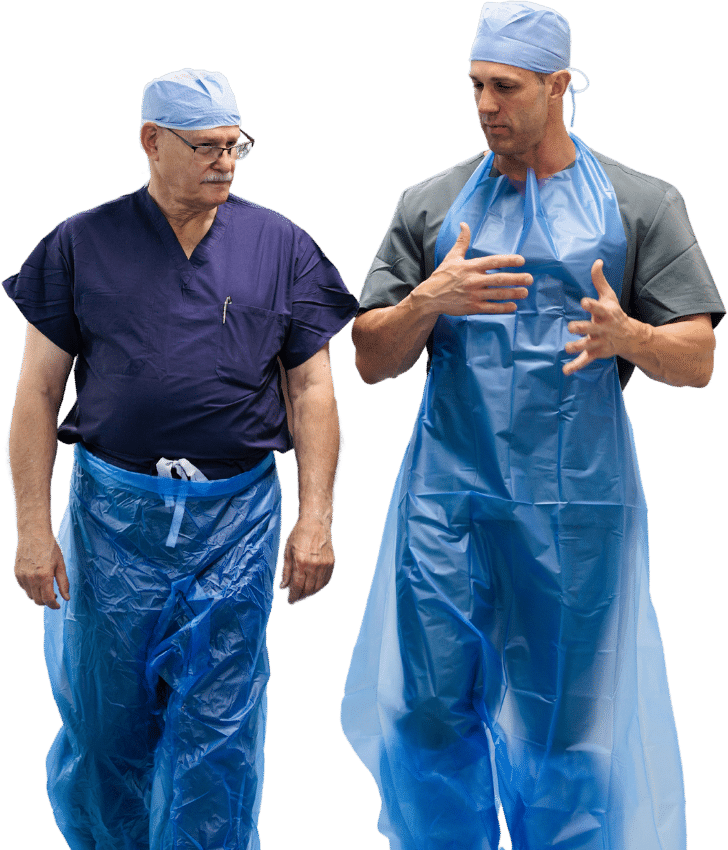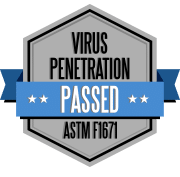Let’s play the acronym game! What do these acronyms all have in common?
- NCLEX-RN.
- USMLE.
- ASTM F1671.
They’re all tests that the medical field relies upon to guarantee that doctors, nurses, and even supplies are qualified to perform their duties.
Where the NCLEX-RN and the USMLE test nurses and doctors, respectively, the ASTM F1671 tests materials used in hospitals and surgical centers. This standard, set by the independent board of ASTM International, focuses on testing the resistance of materials to infectious materials like blood, viral, fluid, and bacterial penetration. It helps ensure that surgical gowns, disposable protective clothing, and drapes effectively protect patients and staff.
According to the CDC, about 10% of patients develop surgical site infections each year in the U.S. And according to an NIH study, over half (52.1%) of nurses experience occupational exposure to blood or body fluids.
The right surgical materials can help reduce this risk. ASTM standard F1670 helps healthcare providers understand when (and if) they’re choosing the right PPE at a glance.
What are ASTM International Standards?
ASTM International standards are rules for materials, products, and services. ASTM stands for the American Society for Testing and Materials, a worldwide organization that creates guidelines to help ensure safety and quality.
ASTM standards are important for businesses and consumers. They ensure products meet certain quality levels, which means they are reliable and effective. Many companies use these standards to improve their products or ensure the safety of their services.
According to ASTM, over 12,000 different standards are available for a variety of industries, manufacturers, and purposes. For example, ASTM standards help builders determine the right materials to use for strong structures. One specific ASTM standard is designed to help surgeons and purchasing managers choose reliable, impermeable disposable medical protective clothing.
The ASTM F1671 Standard
The ASTM F1671 standard is that standard. It’s important for testing materials used in medical settings because it measures how well a fabric resists the passage of viruses.
This standard helps ensure that protective clothing keeps healthcare workers safe.
To perform the test, a sample of a given material is laid atop a permeable surface and exposed to a virus solution. The test uses a specific type of virus, MS2 bacteriophage.
After exposure, the tested material is removed from the control material, which is then checked for any viruses that pass through. The amount of virus on the other side is measured.
A material earns a passing score if less than 1% of the infectious material is detected. This means the fabric effectively blocked the virus. According to the ASTM F1671, products that meet this standard offer a reliable barrier against bloodborne pathogens.
This standard is crucial for keeping patients and medical staff healthy.
Current Standards and Specifications for Protective Clothing & PPE
Current standards for disposable protective clothing used in healthcare settings ensure safety for both patients and medical staff. The main guidelines come from organizations like the American National Standards Institute (ANSI) and the American Society for Testing and Materials (ASTM).
These bodies set rules for the materials used in protective clothing. For example, gowns must resist liquids and infectious material and allow movement, airflow, and comfort. ASTM F1670 and F1671 are tests that measure how well materials handle fluids and biological hazards.
Protective clothing usually comes in categories. Level 1 is the least protective, and Level 4 offers the highest protection. Healthcare workers should use Level 2 or 3 during surgeries, and the PPE used should pass the standards for viral penetration. According to the Centers for Disease Control and Prevention (CDC), proper protective wear can reduce infection rates by at least 70%.
Disposable clothing must fit well and be easy to put on and take off to prevent contamination. Regular updates to these standards help keep healthcare workers safe and ensure patient protection.
OSHA Requirements for Protecting Employees From Bloodborne Pathogens
Contact with blood can be extremely dangerous for healthcare workers. That’s why the Occupational Safety and Health Administration (OSHA) sets rules to protect healthcare workers from bloodborne pathogens. Bloodborne pathogens are germs found in blood that can cause diseases like HIV and hepatitis B. These diseases can spread through contact with infected blood or certain body fluids and other infectious materials.
OSHA has specific standards for hospitals and clinics. One key requirement is the Bloodborne Pathogens Standard. This standard states that employers must have a written exposure control plan. This plan must outline how to minimize the risk of exposure to human blood and bloodborne pathogens. Your exposure control plan should include the use of impermeable, F1671-tested PPE.
Training is also important. Healthcare workers must receive training on how to handle blood safely. They should also learn about the proper use of personal protective equipment (PPE), such as shoe covers, medical leggings, aprons, jumpsuits, and other disposable protective medical clothing.
Employers must also offer hepatitis B vaccinations to workers who are at risk of exposure.
According to OSHA, proper training and safety measures can reduce workplace injuries by 80% (OSHA, 2020). Following these guidelines helps keep healthcare workers safe while they care for others.
Why Impermeability Matters
Medical protective clothing must be fluid-impermeable to prevent the transmission of infectious agents, bodily fluids, and hazardous substances to healthcare workers and patients. This impermeability ensures a barrier that protects the skin and prevents contamination, particularly in environments where exposure to blood, saliva, or other fluids may occur.
Protecting Patients
Using fluid-impermeable personal protective equipment (PPE) is essential for protecting patients.
PPE, such as gowns, gloves, and masks, prevents the direct contact of bodily fluids, blood, and other potentially contaminated materials with healthcare providers, thereby reducing the risk of cross-contamination.
This is particularly crucial during procedures that are fluid or blood-intensive. or involve high-risk exposure to infectious agents.
The use of fluid-impermeable materials helps maintain a sterile environment, ultimately contributing to better patient outcomes and minimizing the spread of healthcare-associated infections.
Protecting Staff
Providing truly impermeable personal protective equipment (PPE) to your healthcare staff offers numerous benefits. It enhances employee safety and boosts morale while reducing sick-outs and turnover. It can also protect your hospital’s reputation.
High-quality PPE significantly reduces the risk of infection and illness among healthcare workers, leading to lower absenteeism and higher morale, which ultimately contributes to better patient outcomes.
Additionally, when staff members feel protected by reliable equipment, it fosters a culture of safety within the healthcare environment, encouraging them to perform their duties with confidence and effectiveness.
Moreover, providing exceptional PPE can protect your healthcare facility’s reputation by reducing the number and likelihood of healthcare-acquired infections in your patients and staff. This helps attract top talent and instills trust among patients and their families in the community.
In the long run, investing in superior PPE can lead to cost savings by minimizing the costs associated with workplace injuries and infection control, ultimately supporting the overall sustainability of healthcare operations.
Don’t Sweat the Wet
We’re on a mission to keep every doctor, surgeon, nurse, and technician safe and dry through every procedure. We’ve designed our PPE garments to be lightweight, durable, and—yes—impenetrable, impermeable, and tested to meet ASTM F1671 standards.
Our STA-DRI and ezGLIDE® products were designed by urologist Dr. Stewart Sloan just for healthcare professionals. We take pride in producing truly impervious and slip-resistant disposable protective clothing, tested to ensure the highest quality protection against fluids and contaminants. Sloan Medical is confident that if you try our products, you’ll never go back. So, before you go, claim your free STA-DRI samples and see the difference for yourself.





